Unit 13: Costs and Revenues Report - Marks and Spencer Analysis
VerifiedAdded on 2021/01/01
|19
|3336
|51
Report
AI Summary
This report provides a comprehensive analysis of costs and revenues, focusing on the context of Marks and Spencer. It begins by exploring the purpose of internal reporting and the relationship between various costing systems, including historical, absorption, and direct costing. The report then delves into responsibility centers, cost classifications, and the differences between marginal and absorption costing. The core of the report includes detailed cost information for materials, labor, and expenses, along with an examination of inventory valuation methods (FIFO, LIFO, weighted average) and cost behavior. It also covers costing systems like job, batch, unit, process, and service costing. The report further addresses overhead allocation, absorption rates, and variance analysis, including budget versus actual costs. Finally, it touches on the preparation of future income and cost estimates for decision-making and factors affecting short-term and long-term decision making.
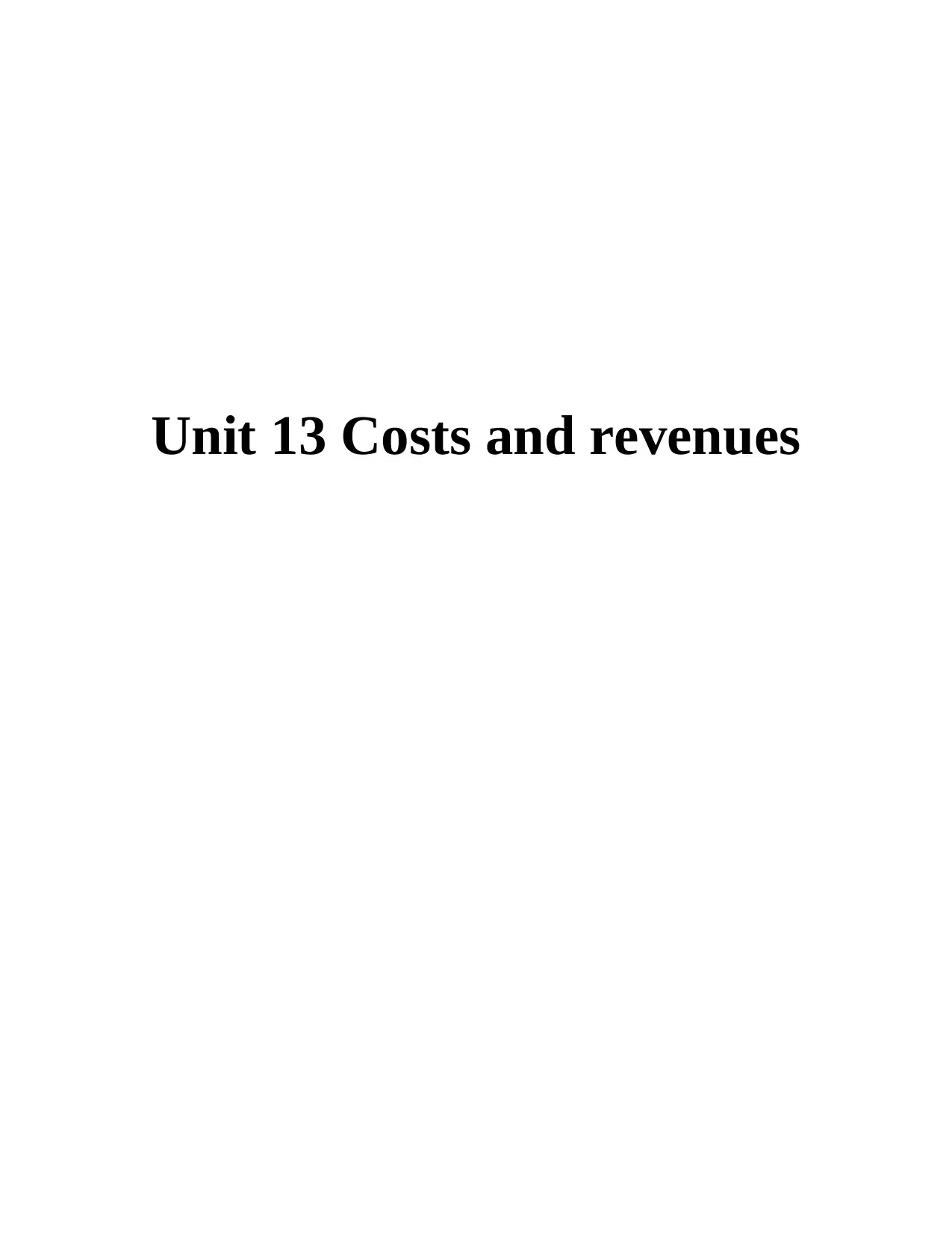
Unit 13 Costs and revenues
Paraphrase This Document
Need a fresh take? Get an instant paraphrase of this document with our AI Paraphraser
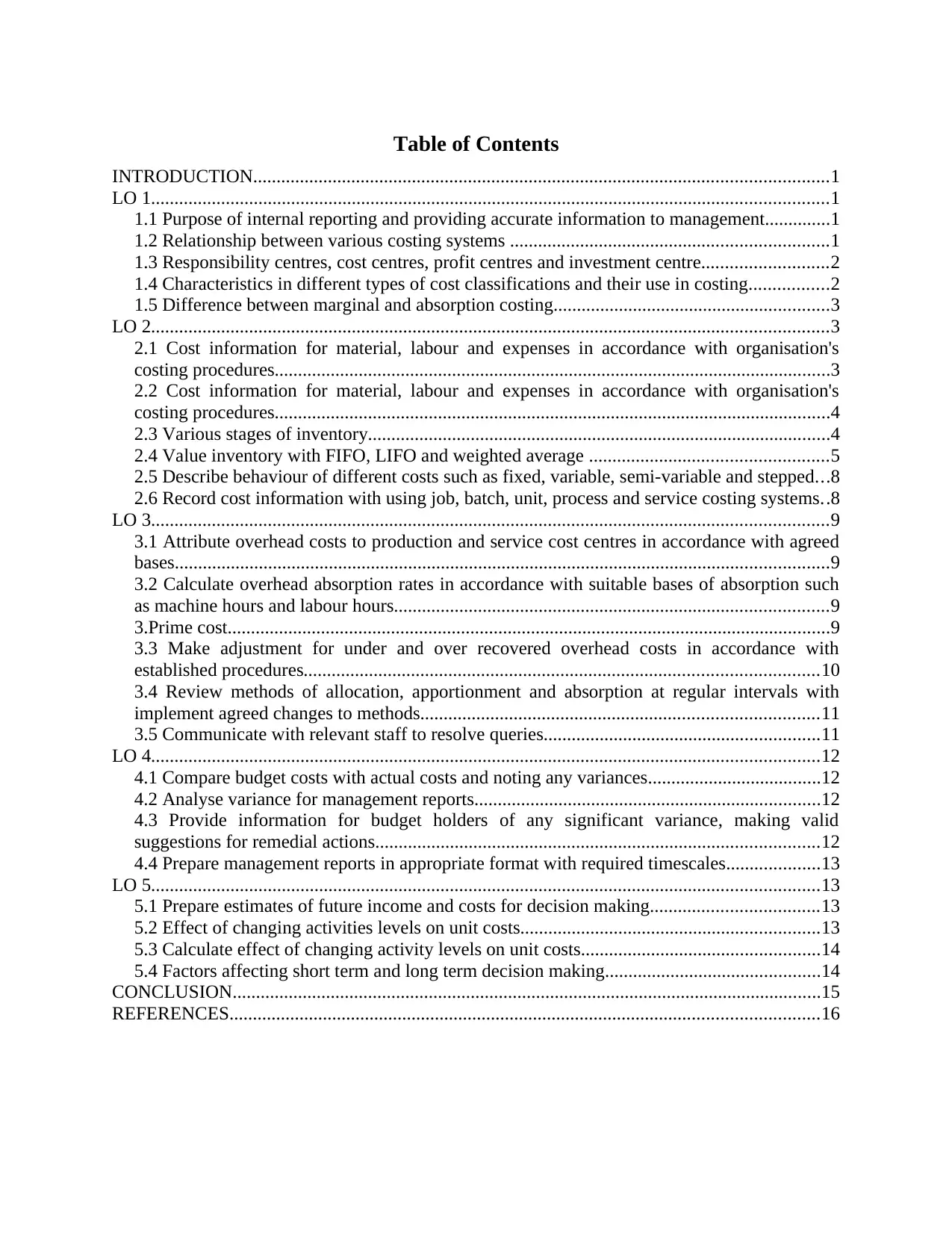
Table of Contents
INTRODUCTION...........................................................................................................................1
LO 1.................................................................................................................................................1
1.1 Purpose of internal reporting and providing accurate information to management..............1
1.2 Relationship between various costing systems ....................................................................1
1.3 Responsibility centres, cost centres, profit centres and investment centre...........................2
1.4 Characteristics in different types of cost classifications and their use in costing.................2
1.5 Difference between marginal and absorption costing...........................................................3
LO 2.................................................................................................................................................3
2.1 Cost information for material, labour and expenses in accordance with organisation's
costing procedures.......................................................................................................................3
2.2 Cost information for material, labour and expenses in accordance with organisation's
costing procedures.......................................................................................................................4
2.3 Various stages of inventory...................................................................................................4
2.4 Value inventory with FIFO, LIFO and weighted average ...................................................5
2.5 Describe behaviour of different costs such as fixed, variable, semi-variable and stepped...8
2.6 Record cost information with using job, batch, unit, process and service costing systems..8
LO 3.................................................................................................................................................9
3.1 Attribute overhead costs to production and service cost centres in accordance with agreed
bases............................................................................................................................................9
3.2 Calculate overhead absorption rates in accordance with suitable bases of absorption such
as machine hours and labour hours.............................................................................................9
3.Prime cost.................................................................................................................................9
3.3 Make adjustment for under and over recovered overhead costs in accordance with
established procedures..............................................................................................................10
3.4 Review methods of allocation, apportionment and absorption at regular intervals with
implement agreed changes to methods.....................................................................................11
3.5 Communicate with relevant staff to resolve queries...........................................................11
LO 4...............................................................................................................................................12
4.1 Compare budget costs with actual costs and noting any variances.....................................12
4.2 Analyse variance for management reports..........................................................................12
4.3 Provide information for budget holders of any significant variance, making valid
suggestions for remedial actions...............................................................................................12
4.4 Prepare management reports in appropriate format with required timescales....................13
LO 5...............................................................................................................................................13
5.1 Prepare estimates of future income and costs for decision making....................................13
5.2 Effect of changing activities levels on unit costs................................................................13
5.3 Calculate effect of changing activity levels on unit costs...................................................14
5.4 Factors affecting short term and long term decision making..............................................14
CONCLUSION..............................................................................................................................15
REFERENCES..............................................................................................................................16
INTRODUCTION...........................................................................................................................1
LO 1.................................................................................................................................................1
1.1 Purpose of internal reporting and providing accurate information to management..............1
1.2 Relationship between various costing systems ....................................................................1
1.3 Responsibility centres, cost centres, profit centres and investment centre...........................2
1.4 Characteristics in different types of cost classifications and their use in costing.................2
1.5 Difference between marginal and absorption costing...........................................................3
LO 2.................................................................................................................................................3
2.1 Cost information for material, labour and expenses in accordance with organisation's
costing procedures.......................................................................................................................3
2.2 Cost information for material, labour and expenses in accordance with organisation's
costing procedures.......................................................................................................................4
2.3 Various stages of inventory...................................................................................................4
2.4 Value inventory with FIFO, LIFO and weighted average ...................................................5
2.5 Describe behaviour of different costs such as fixed, variable, semi-variable and stepped...8
2.6 Record cost information with using job, batch, unit, process and service costing systems..8
LO 3.................................................................................................................................................9
3.1 Attribute overhead costs to production and service cost centres in accordance with agreed
bases............................................................................................................................................9
3.2 Calculate overhead absorption rates in accordance with suitable bases of absorption such
as machine hours and labour hours.............................................................................................9
3.Prime cost.................................................................................................................................9
3.3 Make adjustment for under and over recovered overhead costs in accordance with
established procedures..............................................................................................................10
3.4 Review methods of allocation, apportionment and absorption at regular intervals with
implement agreed changes to methods.....................................................................................11
3.5 Communicate with relevant staff to resolve queries...........................................................11
LO 4...............................................................................................................................................12
4.1 Compare budget costs with actual costs and noting any variances.....................................12
4.2 Analyse variance for management reports..........................................................................12
4.3 Provide information for budget holders of any significant variance, making valid
suggestions for remedial actions...............................................................................................12
4.4 Prepare management reports in appropriate format with required timescales....................13
LO 5...............................................................................................................................................13
5.1 Prepare estimates of future income and costs for decision making....................................13
5.2 Effect of changing activities levels on unit costs................................................................13
5.3 Calculate effect of changing activity levels on unit costs...................................................14
5.4 Factors affecting short term and long term decision making..............................................14
CONCLUSION..............................................................................................................................15
REFERENCES..............................................................................................................................16
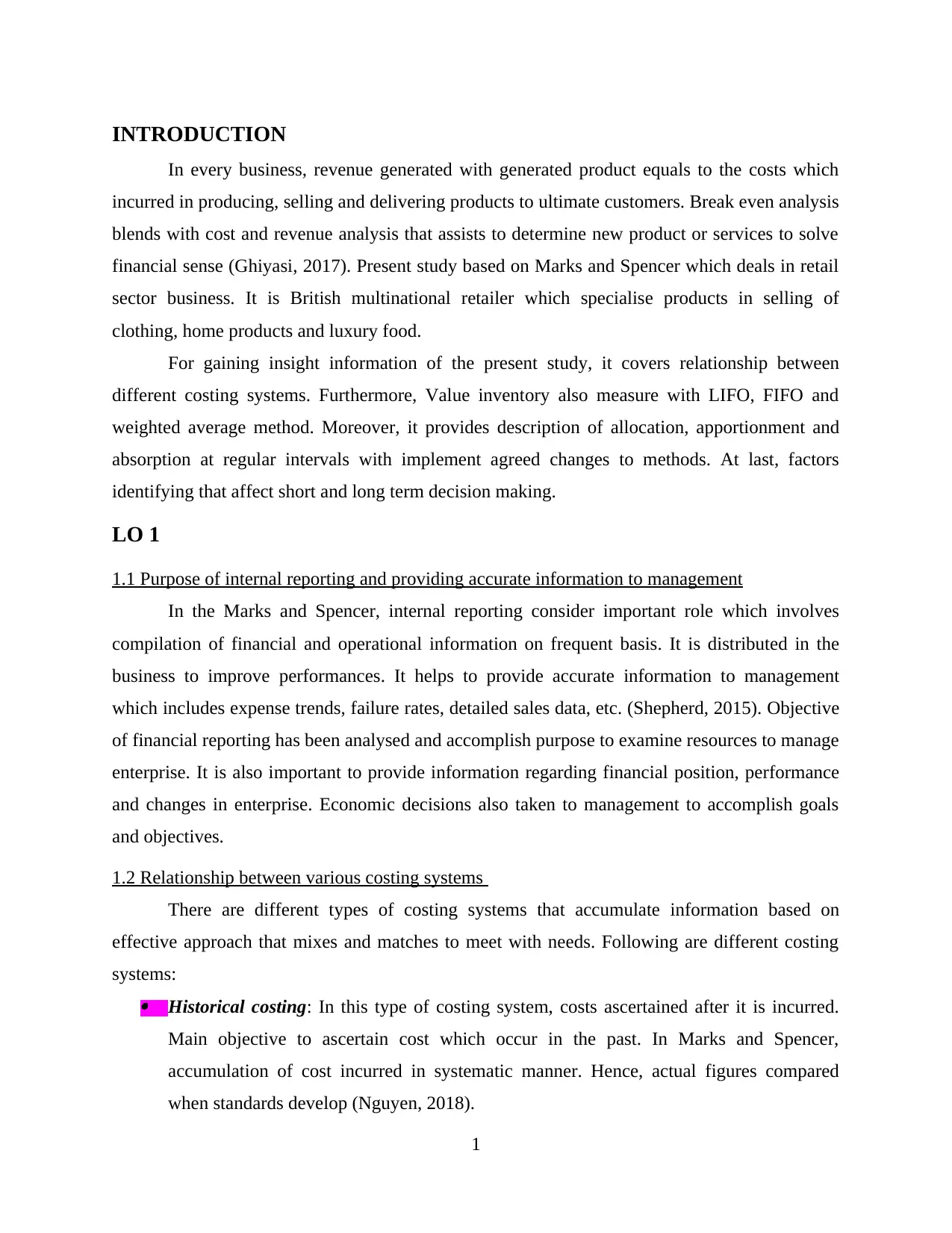
INTRODUCTION
In every business, revenue generated with generated product equals to the costs which
incurred in producing, selling and delivering products to ultimate customers. Break even analysis
blends with cost and revenue analysis that assists to determine new product or services to solve
financial sense (Ghiyasi, 2017). Present study based on Marks and Spencer which deals in retail
sector business. It is British multinational retailer which specialise products in selling of
clothing, home products and luxury food.
For gaining insight information of the present study, it covers relationship between
different costing systems. Furthermore, Value inventory also measure with LIFO, FIFO and
weighted average method. Moreover, it provides description of allocation, apportionment and
absorption at regular intervals with implement agreed changes to methods. At last, factors
identifying that affect short and long term decision making.
LO 1
1.1 Purpose of internal reporting and providing accurate information to management
In the Marks and Spencer, internal reporting consider important role which involves
compilation of financial and operational information on frequent basis. It is distributed in the
business to improve performances. It helps to provide accurate information to management
which includes expense trends, failure rates, detailed sales data, etc. (Shepherd, 2015). Objective
of financial reporting has been analysed and accomplish purpose to examine resources to manage
enterprise. It is also important to provide information regarding financial position, performance
and changes in enterprise. Economic decisions also taken to management to accomplish goals
and objectives.
1.2 Relationship between various costing systems
There are different types of costing systems that accumulate information based on
effective approach that mixes and matches to meet with needs. Following are different costing
systems: Historical costing: In this type of costing system, costs ascertained after it is incurred.
Main objective to ascertain cost which occur in the past. In Marks and Spencer,
accumulation of cost incurred in systematic manner. Hence, actual figures compared
when standards develop (Nguyen, 2018).
1
In every business, revenue generated with generated product equals to the costs which
incurred in producing, selling and delivering products to ultimate customers. Break even analysis
blends with cost and revenue analysis that assists to determine new product or services to solve
financial sense (Ghiyasi, 2017). Present study based on Marks and Spencer which deals in retail
sector business. It is British multinational retailer which specialise products in selling of
clothing, home products and luxury food.
For gaining insight information of the present study, it covers relationship between
different costing systems. Furthermore, Value inventory also measure with LIFO, FIFO and
weighted average method. Moreover, it provides description of allocation, apportionment and
absorption at regular intervals with implement agreed changes to methods. At last, factors
identifying that affect short and long term decision making.
LO 1
1.1 Purpose of internal reporting and providing accurate information to management
In the Marks and Spencer, internal reporting consider important role which involves
compilation of financial and operational information on frequent basis. It is distributed in the
business to improve performances. It helps to provide accurate information to management
which includes expense trends, failure rates, detailed sales data, etc. (Shepherd, 2015). Objective
of financial reporting has been analysed and accomplish purpose to examine resources to manage
enterprise. It is also important to provide information regarding financial position, performance
and changes in enterprise. Economic decisions also taken to management to accomplish goals
and objectives.
1.2 Relationship between various costing systems
There are different types of costing systems that accumulate information based on
effective approach that mixes and matches to meet with needs. Following are different costing
systems: Historical costing: In this type of costing system, costs ascertained after it is incurred.
Main objective to ascertain cost which occur in the past. In Marks and Spencer,
accumulation of cost incurred in systematic manner. Hence, actual figures compared
when standards develop (Nguyen, 2018).
1
⊘ This is a preview!⊘
Do you want full access?
Subscribe today to unlock all pages.

Trusted by 1+ million students worldwide
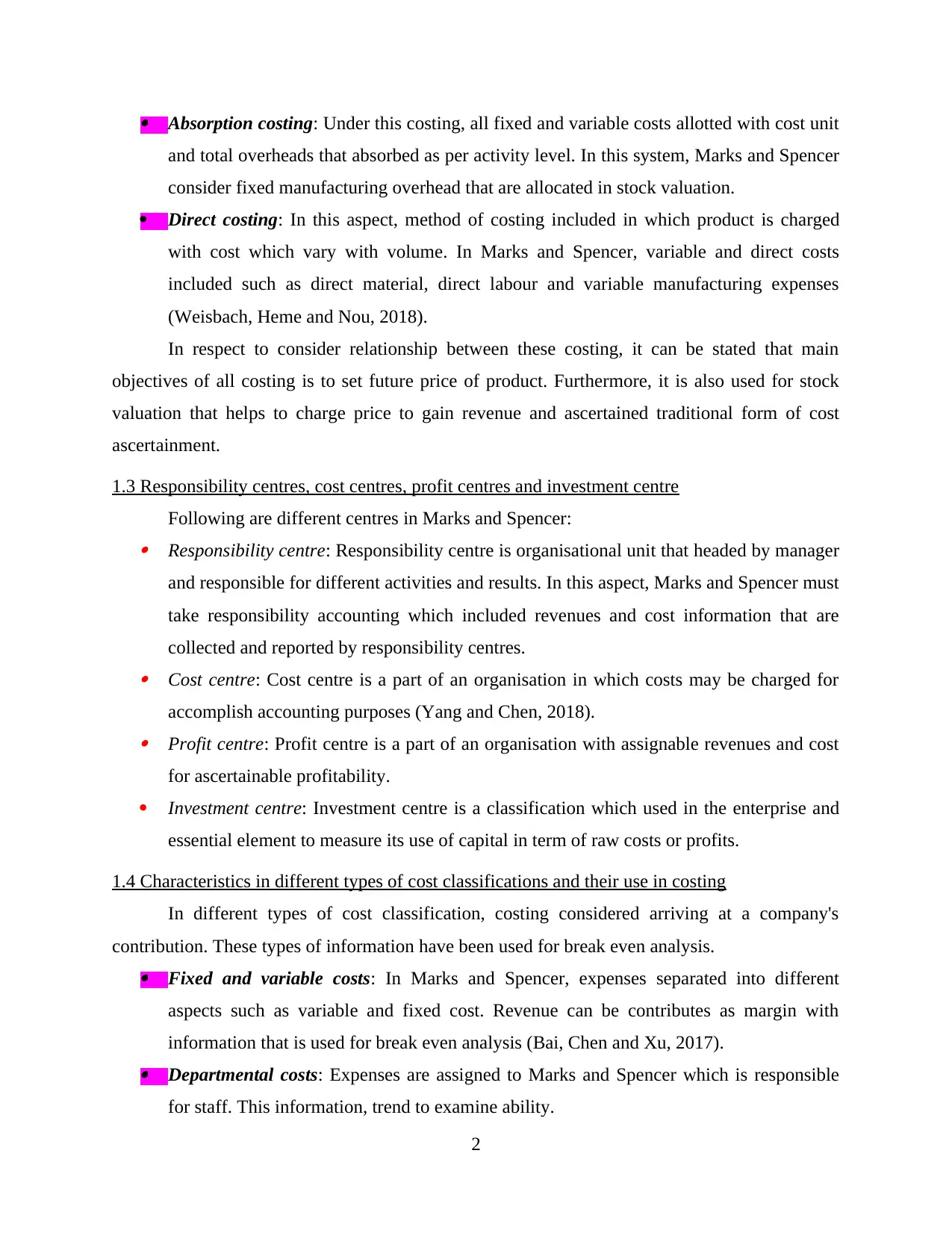
Absorption costing: Under this costing, all fixed and variable costs allotted with cost unit
and total overheads that absorbed as per activity level. In this system, Marks and Spencer
consider fixed manufacturing overhead that are allocated in stock valuation.
Direct costing: In this aspect, method of costing included in which product is charged
with cost which vary with volume. In Marks and Spencer, variable and direct costs
included such as direct material, direct labour and variable manufacturing expenses
(Weisbach, Heme and Nou, 2018).
In respect to consider relationship between these costing, it can be stated that main
objectives of all costing is to set future price of product. Furthermore, it is also used for stock
valuation that helps to charge price to gain revenue and ascertained traditional form of cost
ascertainment.
1.3 Responsibility centres, cost centres, profit centres and investment centre
Following are different centres in Marks and Spencer: Responsibility centre: Responsibility centre is organisational unit that headed by manager
and responsible for different activities and results. In this aspect, Marks and Spencer must
take responsibility accounting which included revenues and cost information that are
collected and reported by responsibility centres. Cost centre: Cost centre is a part of an organisation in which costs may be charged for
accomplish accounting purposes (Yang and Chen, 2018). Profit centre: Profit centre is a part of an organisation with assignable revenues and cost
for ascertainable profitability.
Investment centre: Investment centre is a classification which used in the enterprise and
essential element to measure its use of capital in term of raw costs or profits.
1.4 Characteristics in different types of cost classifications and their use in costing
In different types of cost classification, costing considered arriving at a company's
contribution. These types of information have been used for break even analysis. Fixed and variable costs: In Marks and Spencer, expenses separated into different
aspects such as variable and fixed cost. Revenue can be contributes as margin with
information that is used for break even analysis (Bai, Chen and Xu, 2017). Departmental costs: Expenses are assigned to Marks and Spencer which is responsible
for staff. This information, trend to examine ability.
2
and total overheads that absorbed as per activity level. In this system, Marks and Spencer
consider fixed manufacturing overhead that are allocated in stock valuation.
Direct costing: In this aspect, method of costing included in which product is charged
with cost which vary with volume. In Marks and Spencer, variable and direct costs
included such as direct material, direct labour and variable manufacturing expenses
(Weisbach, Heme and Nou, 2018).
In respect to consider relationship between these costing, it can be stated that main
objectives of all costing is to set future price of product. Furthermore, it is also used for stock
valuation that helps to charge price to gain revenue and ascertained traditional form of cost
ascertainment.
1.3 Responsibility centres, cost centres, profit centres and investment centre
Following are different centres in Marks and Spencer: Responsibility centre: Responsibility centre is organisational unit that headed by manager
and responsible for different activities and results. In this aspect, Marks and Spencer must
take responsibility accounting which included revenues and cost information that are
collected and reported by responsibility centres. Cost centre: Cost centre is a part of an organisation in which costs may be charged for
accomplish accounting purposes (Yang and Chen, 2018). Profit centre: Profit centre is a part of an organisation with assignable revenues and cost
for ascertainable profitability.
Investment centre: Investment centre is a classification which used in the enterprise and
essential element to measure its use of capital in term of raw costs or profits.
1.4 Characteristics in different types of cost classifications and their use in costing
In different types of cost classification, costing considered arriving at a company's
contribution. These types of information have been used for break even analysis. Fixed and variable costs: In Marks and Spencer, expenses separated into different
aspects such as variable and fixed cost. Revenue can be contributes as margin with
information that is used for break even analysis (Bai, Chen and Xu, 2017). Departmental costs: Expenses are assigned to Marks and Spencer which is responsible
for staff. This information, trend to examine ability.
2
Paraphrase This Document
Need a fresh take? Get an instant paraphrase of this document with our AI Paraphraser
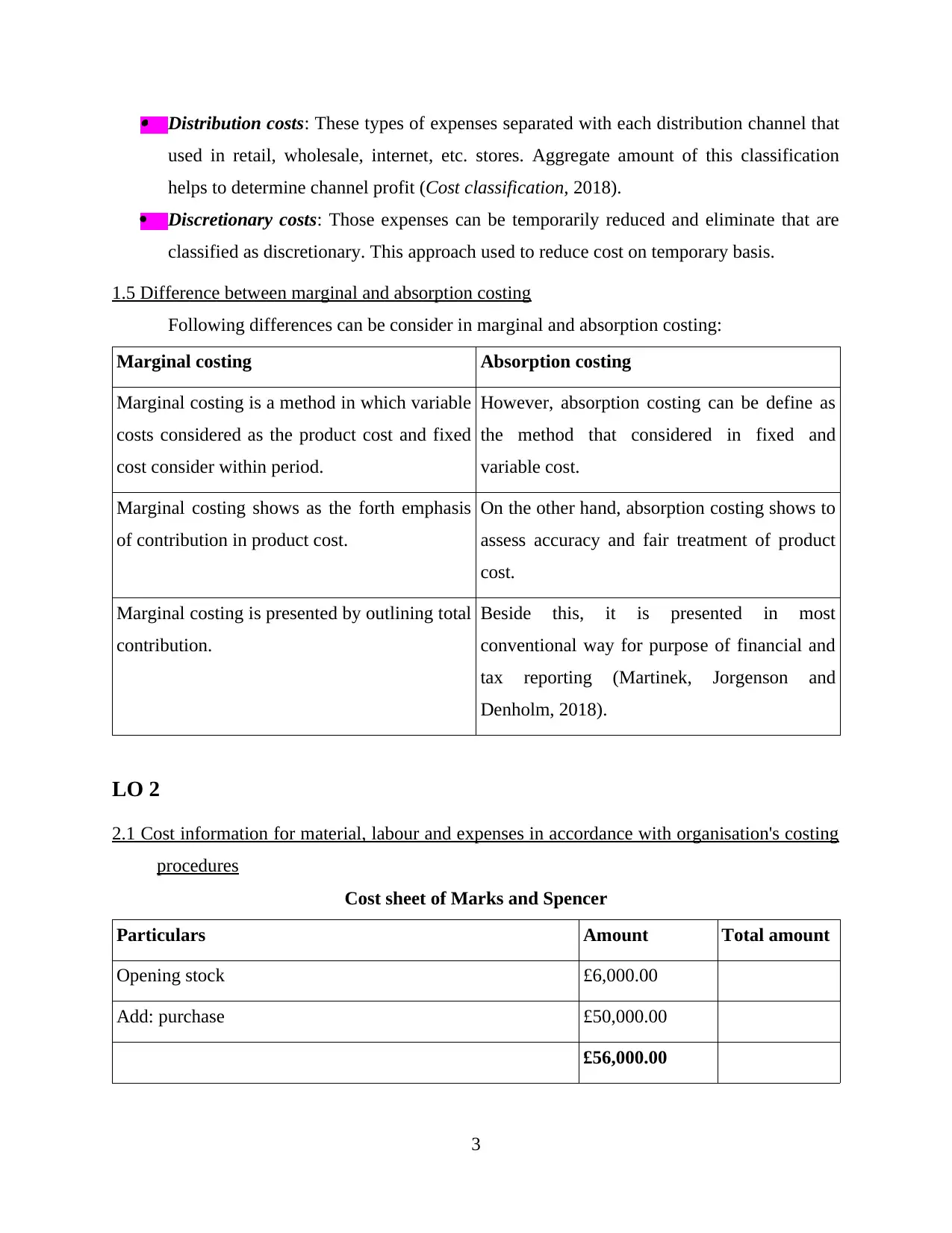
Distribution costs: These types of expenses separated with each distribution channel that
used in retail, wholesale, internet, etc. stores. Aggregate amount of this classification
helps to determine channel profit (Cost classification, 2018).
Discretionary costs: Those expenses can be temporarily reduced and eliminate that are
classified as discretionary. This approach used to reduce cost on temporary basis.
1.5 Difference between marginal and absorption costing
Following differences can be consider in marginal and absorption costing:
Marginal costing Absorption costing
Marginal costing is a method in which variable
costs considered as the product cost and fixed
cost consider within period.
However, absorption costing can be define as
the method that considered in fixed and
variable cost.
Marginal costing shows as the forth emphasis
of contribution in product cost.
On the other hand, absorption costing shows to
assess accuracy and fair treatment of product
cost.
Marginal costing is presented by outlining total
contribution.
Beside this, it is presented in most
conventional way for purpose of financial and
tax reporting (Martinek, Jorgenson and
Denholm, 2018).
LO 2
2.1 Cost information for material, labour and expenses in accordance with organisation's costing
procedures
Cost sheet of Marks and Spencer
Particulars Amount Total amount
Opening stock £6,000.00
Add: purchase £50,000.00
£56,000.00
3
used in retail, wholesale, internet, etc. stores. Aggregate amount of this classification
helps to determine channel profit (Cost classification, 2018).
Discretionary costs: Those expenses can be temporarily reduced and eliminate that are
classified as discretionary. This approach used to reduce cost on temporary basis.
1.5 Difference between marginal and absorption costing
Following differences can be consider in marginal and absorption costing:
Marginal costing Absorption costing
Marginal costing is a method in which variable
costs considered as the product cost and fixed
cost consider within period.
However, absorption costing can be define as
the method that considered in fixed and
variable cost.
Marginal costing shows as the forth emphasis
of contribution in product cost.
On the other hand, absorption costing shows to
assess accuracy and fair treatment of product
cost.
Marginal costing is presented by outlining total
contribution.
Beside this, it is presented in most
conventional way for purpose of financial and
tax reporting (Martinek, Jorgenson and
Denholm, 2018).
LO 2
2.1 Cost information for material, labour and expenses in accordance with organisation's costing
procedures
Cost sheet of Marks and Spencer
Particulars Amount Total amount
Opening stock £6,000.00
Add: purchase £50,000.00
£56,000.00
3
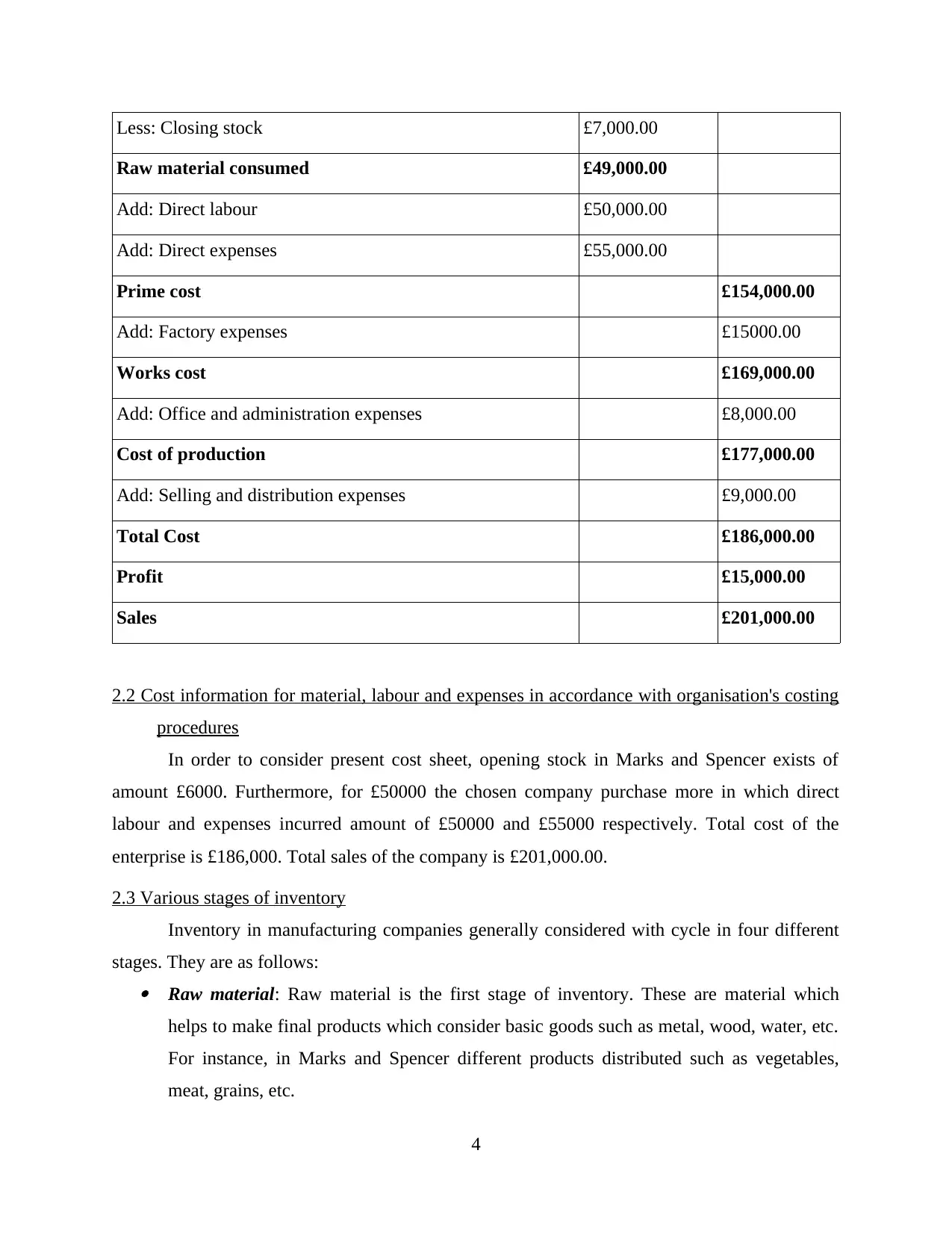
Less: Closing stock £7,000.00
Raw material consumed £49,000.00
Add: Direct labour £50,000.00
Add: Direct expenses £55,000.00
Prime cost £154,000.00
Add: Factory expenses £15000.00
Works cost £169,000.00
Add: Office and administration expenses £8,000.00
Cost of production £177,000.00
Add: Selling and distribution expenses £9,000.00
Total Cost £186,000.00
Profit £15,000.00
Sales £201,000.00
2.2 Cost information for material, labour and expenses in accordance with organisation's costing
procedures
In order to consider present cost sheet, opening stock in Marks and Spencer exists of
amount £6000. Furthermore, for £50000 the chosen company purchase more in which direct
labour and expenses incurred amount of £50000 and £55000 respectively. Total cost of the
enterprise is £186,000. Total sales of the company is £201,000.00.
2.3 Various stages of inventory
Inventory in manufacturing companies generally considered with cycle in four different
stages. They are as follows: Raw material: Raw material is the first stage of inventory. These are material which
helps to make final products which consider basic goods such as metal, wood, water, etc.
For instance, in Marks and Spencer different products distributed such as vegetables,
meat, grains, etc.
4
Raw material consumed £49,000.00
Add: Direct labour £50,000.00
Add: Direct expenses £55,000.00
Prime cost £154,000.00
Add: Factory expenses £15000.00
Works cost £169,000.00
Add: Office and administration expenses £8,000.00
Cost of production £177,000.00
Add: Selling and distribution expenses £9,000.00
Total Cost £186,000.00
Profit £15,000.00
Sales £201,000.00
2.2 Cost information for material, labour and expenses in accordance with organisation's costing
procedures
In order to consider present cost sheet, opening stock in Marks and Spencer exists of
amount £6000. Furthermore, for £50000 the chosen company purchase more in which direct
labour and expenses incurred amount of £50000 and £55000 respectively. Total cost of the
enterprise is £186,000. Total sales of the company is £201,000.00.
2.3 Various stages of inventory
Inventory in manufacturing companies generally considered with cycle in four different
stages. They are as follows: Raw material: Raw material is the first stage of inventory. These are material which
helps to make final products which consider basic goods such as metal, wood, water, etc.
For instance, in Marks and Spencer different products distributed such as vegetables,
meat, grains, etc.
4
⊘ This is a preview!⊘
Do you want full access?
Subscribe today to unlock all pages.

Trusted by 1+ million students worldwide
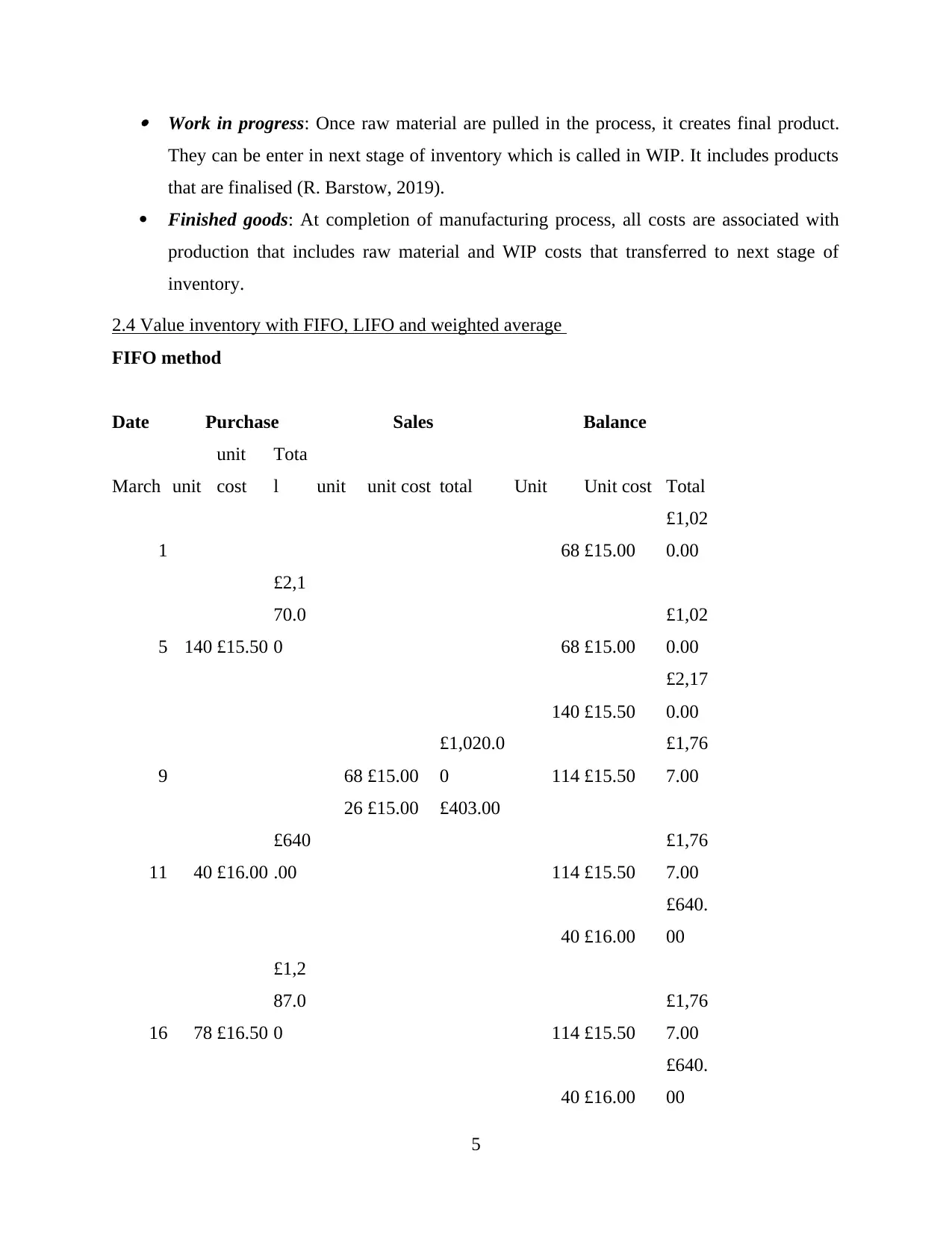
Work in progress: Once raw material are pulled in the process, it creates final product.
They can be enter in next stage of inventory which is called in WIP. It includes products
that are finalised (R. Barstow, 2019).
Finished goods: At completion of manufacturing process, all costs are associated with
production that includes raw material and WIP costs that transferred to next stage of
inventory.
2.4 Value inventory with FIFO, LIFO and weighted average
FIFO method
Date Purchase Sales Balance
March unit
unit
cost
Tota
l unit unit cost total Unit Unit cost Total
1 68 £15.00
£1,02
0.00
5 140 £15.50
£2,1
70.0
0 68 £15.00
£1,02
0.00
140 £15.50
£2,17
0.00
9 68 £15.00
£1,020.0
0 114 £15.50
£1,76
7.00
26 £15.00 £403.00
11 40 £16.00
£640
.00 114 £15.50
£1,76
7.00
40 £16.00
£640.
00
16 78 £16.50
£1,2
87.0
0 114 £15.50
£1,76
7.00
40 £16.00
£640.
00
5
They can be enter in next stage of inventory which is called in WIP. It includes products
that are finalised (R. Barstow, 2019).
Finished goods: At completion of manufacturing process, all costs are associated with
production that includes raw material and WIP costs that transferred to next stage of
inventory.
2.4 Value inventory with FIFO, LIFO and weighted average
FIFO method
Date Purchase Sales Balance
March unit
unit
cost
Tota
l unit unit cost total Unit Unit cost Total
1 68 £15.00
£1,02
0.00
5 140 £15.50
£2,1
70.0
0 68 £15.00
£1,02
0.00
140 £15.50
£2,17
0.00
9 68 £15.00
£1,020.0
0 114 £15.50
£1,76
7.00
26 £15.00 £403.00
11 40 £16.00
£640
.00 114 £15.50
£1,76
7.00
40 £16.00
£640.
00
16 78 £16.50
£1,2
87.0
0 114 £15.50
£1,76
7.00
40 £16.00
£640.
00
5
Paraphrase This Document
Need a fresh take? Get an instant paraphrase of this document with our AI Paraphraser
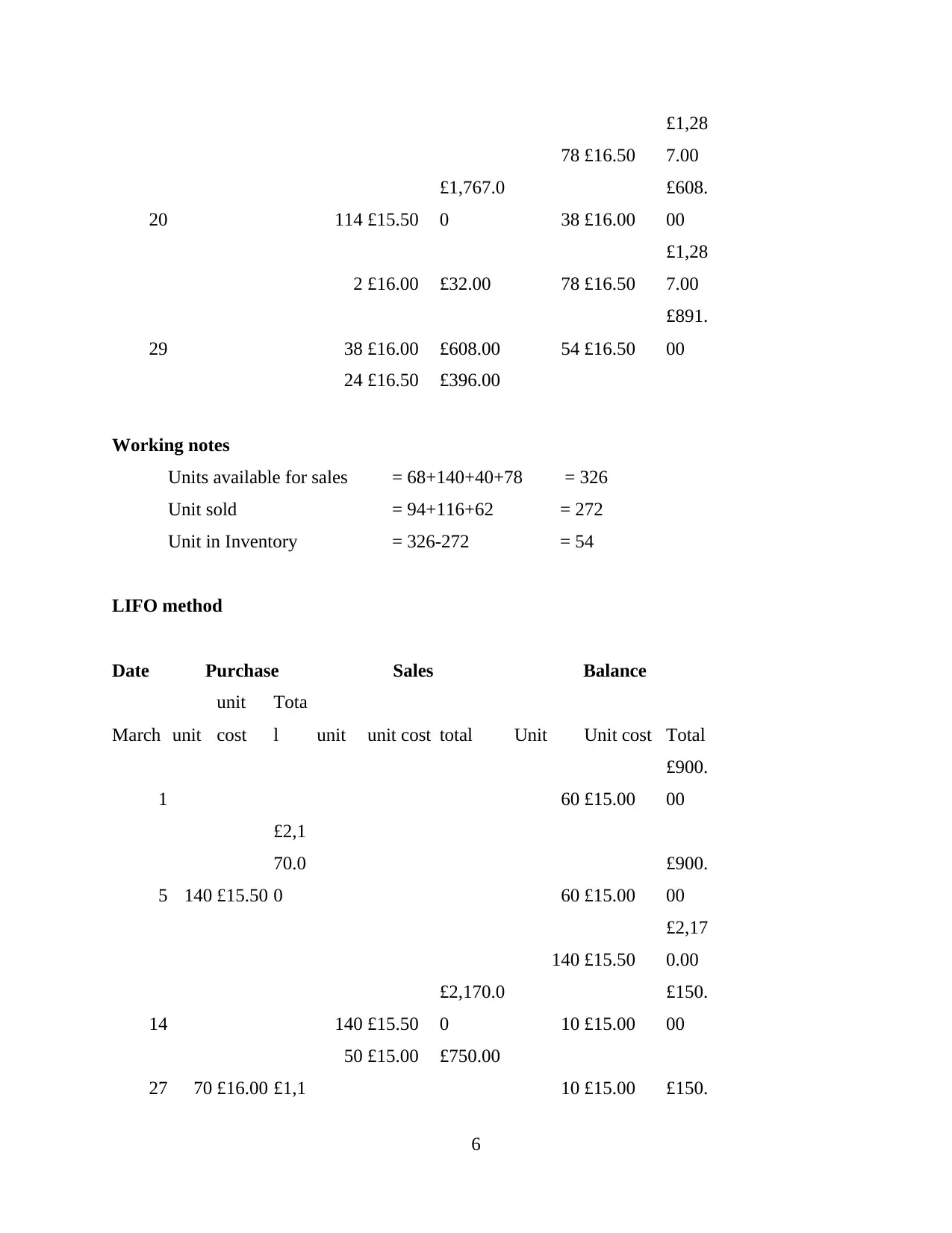
78 £16.50
£1,28
7.00
20 114 £15.50
£1,767.0
0 38 £16.00
£608.
00
2 £16.00 £32.00 78 £16.50
£1,28
7.00
29 38 £16.00 £608.00 54 £16.50
£891.
00
24 £16.50 £396.00
Working notes
Units available for sales = 68+140+40+78 = 326
Unit sold = 94+116+62 = 272
Unit in Inventory = 326-272 = 54
LIFO method
Date Purchase Sales Balance
March unit
unit
cost
Tota
l unit unit cost total Unit Unit cost Total
1 60 £15.00
£900.
00
5 140 £15.50
£2,1
70.0
0 60 £15.00
£900.
00
140 £15.50
£2,17
0.00
14 140 £15.50
£2,170.0
0 10 £15.00
£150.
00
50 £15.00 £750.00
27 70 £16.00 £1,1 10 £15.00 £150.
6
£1,28
7.00
20 114 £15.50
£1,767.0
0 38 £16.00
£608.
00
2 £16.00 £32.00 78 £16.50
£1,28
7.00
29 38 £16.00 £608.00 54 £16.50
£891.
00
24 £16.50 £396.00
Working notes
Units available for sales = 68+140+40+78 = 326
Unit sold = 94+116+62 = 272
Unit in Inventory = 326-272 = 54
LIFO method
Date Purchase Sales Balance
March unit
unit
cost
Tota
l unit unit cost total Unit Unit cost Total
1 60 £15.00
£900.
00
5 140 £15.50
£2,1
70.0
0 60 £15.00
£900.
00
140 £15.50
£2,17
0.00
14 140 £15.50
£2,170.0
0 10 £15.00
£150.
00
50 £15.00 £750.00
27 70 £16.00 £1,1 10 £15.00 £150.
6
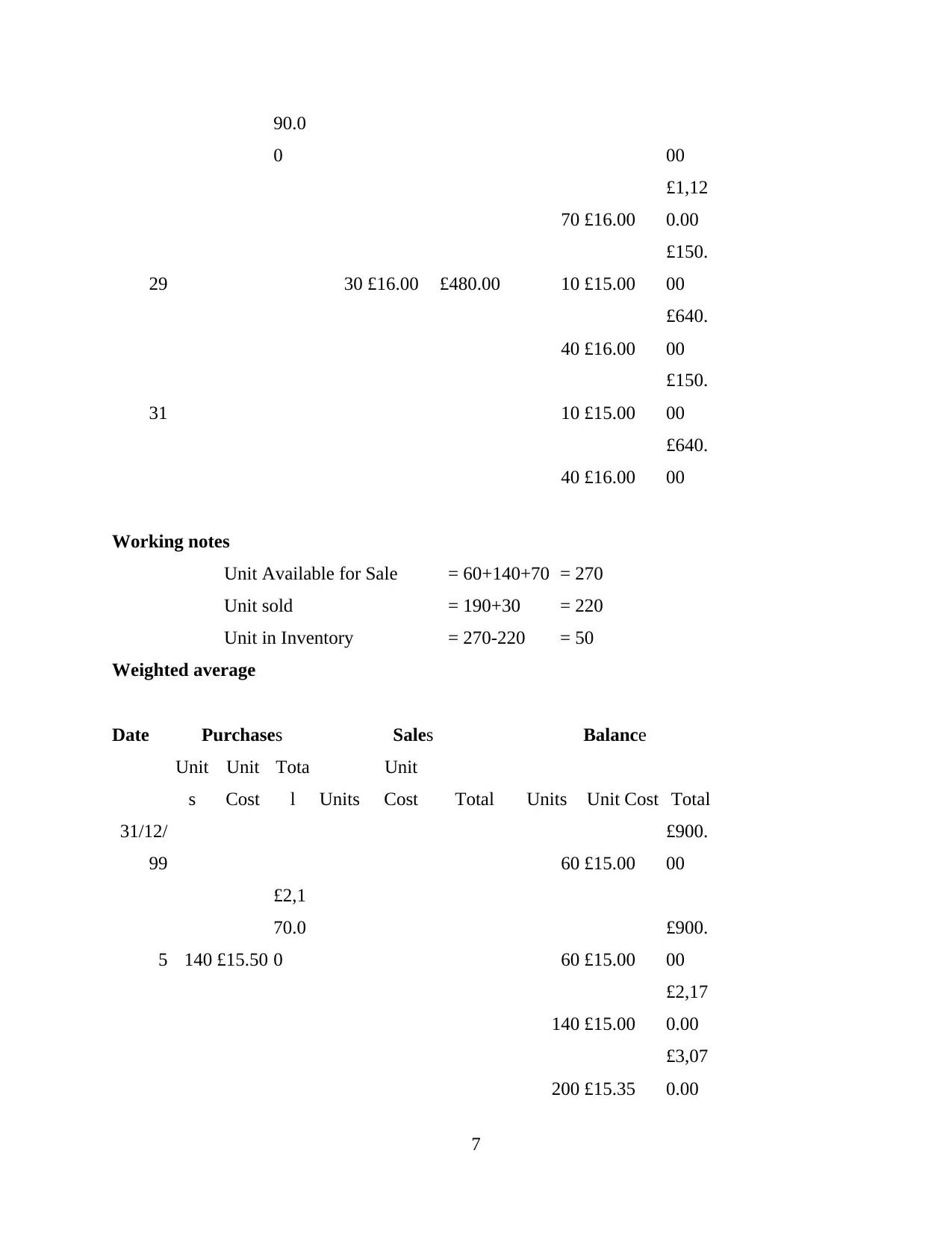
90.0
0 00
70 £16.00
£1,12
0.00
29 30 £16.00 £480.00 10 £15.00
£150.
00
40 £16.00
£640.
00
31 10 £15.00
£150.
00
40 £16.00
£640.
00
Working notes
Unit Available for Sale = 60+140+70 = 270
Unit sold = 190+30 = 220
Unit in Inventory = 270-220 = 50
Weighted average
Date Purchases Sales Balance
Unit
s
Unit
Cost
Tota
l Units
Unit
Cost Total Units Unit Cost Total
31/12/
99 60 £15.00
£900.
00
5 140 £15.50
£2,1
70.0
0 60 £15.00
£900.
00
140 £15.00
£2,17
0.00
200 £15.35
£3,07
0.00
7
0 00
70 £16.00
£1,12
0.00
29 30 £16.00 £480.00 10 £15.00
£150.
00
40 £16.00
£640.
00
31 10 £15.00
£150.
00
40 £16.00
£640.
00
Working notes
Unit Available for Sale = 60+140+70 = 270
Unit sold = 190+30 = 220
Unit in Inventory = 270-220 = 50
Weighted average
Date Purchases Sales Balance
Unit
s
Unit
Cost
Tota
l Units
Unit
Cost Total Units Unit Cost Total
31/12/
99 60 £15.00
£900.
00
5 140 £15.50
£2,1
70.0
0 60 £15.00
£900.
00
140 £15.00
£2,17
0.00
200 £15.35
£3,07
0.00
7
⊘ This is a preview!⊘
Do you want full access?
Subscribe today to unlock all pages.

Trusted by 1+ million students worldwide
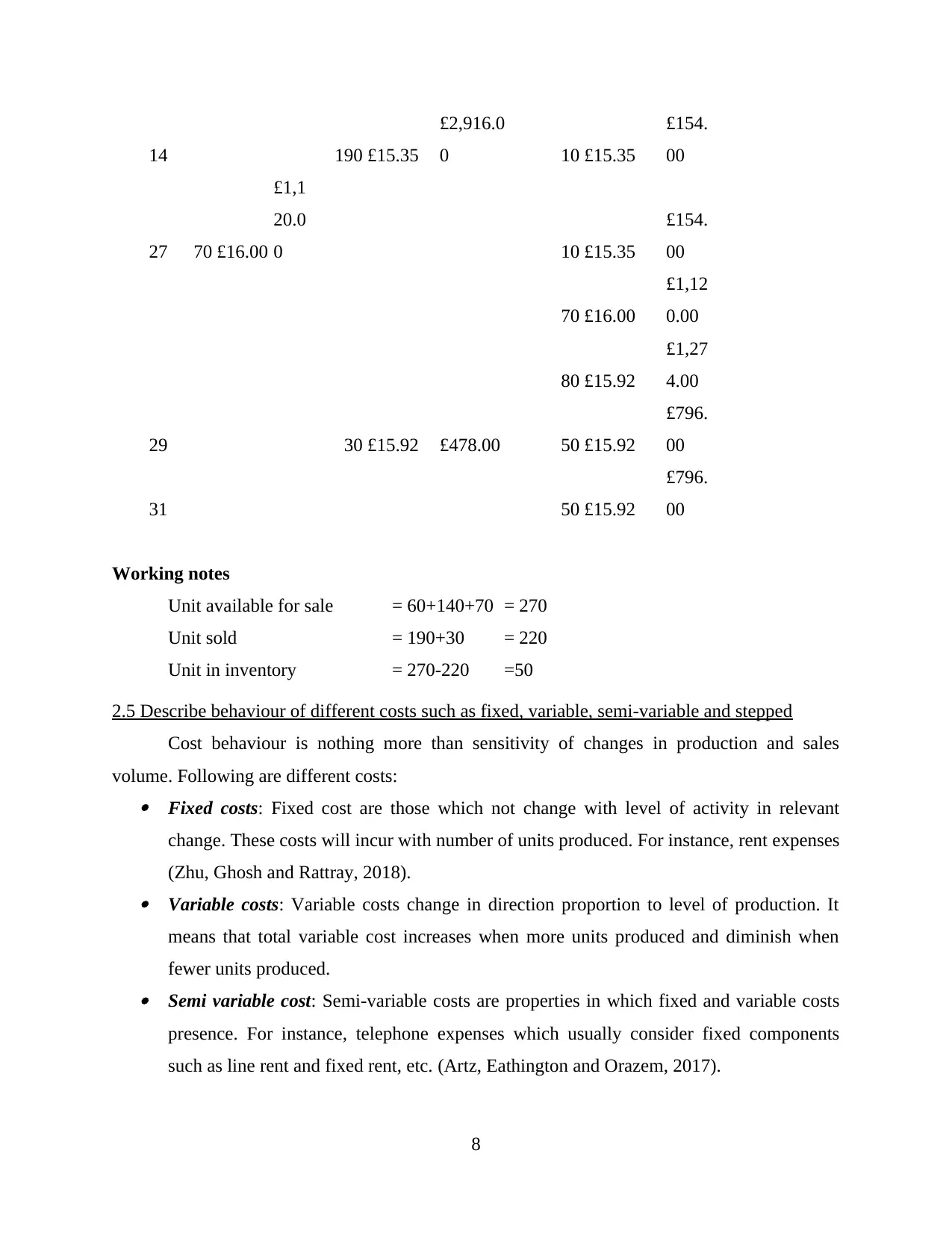
14 190 £15.35
£2,916.0
0 10 £15.35
£154.
00
27 70 £16.00
£1,1
20.0
0 10 £15.35
£154.
00
70 £16.00
£1,12
0.00
80 £15.92
£1,27
4.00
29 30 £15.92 £478.00 50 £15.92
£796.
00
31 50 £15.92
£796.
00
Working notes
Unit available for sale = 60+140+70 = 270
Unit sold = 190+30 = 220
Unit in inventory = 270-220 =50
2.5 Describe behaviour of different costs such as fixed, variable, semi-variable and stepped
Cost behaviour is nothing more than sensitivity of changes in production and sales
volume. Following are different costs: Fixed costs: Fixed cost are those which not change with level of activity in relevant
change. These costs will incur with number of units produced. For instance, rent expenses
(Zhu, Ghosh and Rattray, 2018). Variable costs: Variable costs change in direction proportion to level of production. It
means that total variable cost increases when more units produced and diminish when
fewer units produced. Semi variable cost: Semi-variable costs are properties in which fixed and variable costs
presence. For instance, telephone expenses which usually consider fixed components
such as line rent and fixed rent, etc. (Artz, Eathington and Orazem, 2017).
8
£2,916.0
0 10 £15.35
£154.
00
27 70 £16.00
£1,1
20.0
0 10 £15.35
£154.
00
70 £16.00
£1,12
0.00
80 £15.92
£1,27
4.00
29 30 £15.92 £478.00 50 £15.92
£796.
00
31 50 £15.92
£796.
00
Working notes
Unit available for sale = 60+140+70 = 270
Unit sold = 190+30 = 220
Unit in inventory = 270-220 =50
2.5 Describe behaviour of different costs such as fixed, variable, semi-variable and stepped
Cost behaviour is nothing more than sensitivity of changes in production and sales
volume. Following are different costs: Fixed costs: Fixed cost are those which not change with level of activity in relevant
change. These costs will incur with number of units produced. For instance, rent expenses
(Zhu, Ghosh and Rattray, 2018). Variable costs: Variable costs change in direction proportion to level of production. It
means that total variable cost increases when more units produced and diminish when
fewer units produced. Semi variable cost: Semi-variable costs are properties in which fixed and variable costs
presence. For instance, telephone expenses which usually consider fixed components
such as line rent and fixed rent, etc. (Artz, Eathington and Orazem, 2017).
8
Paraphrase This Document
Need a fresh take? Get an instant paraphrase of this document with our AI Paraphraser
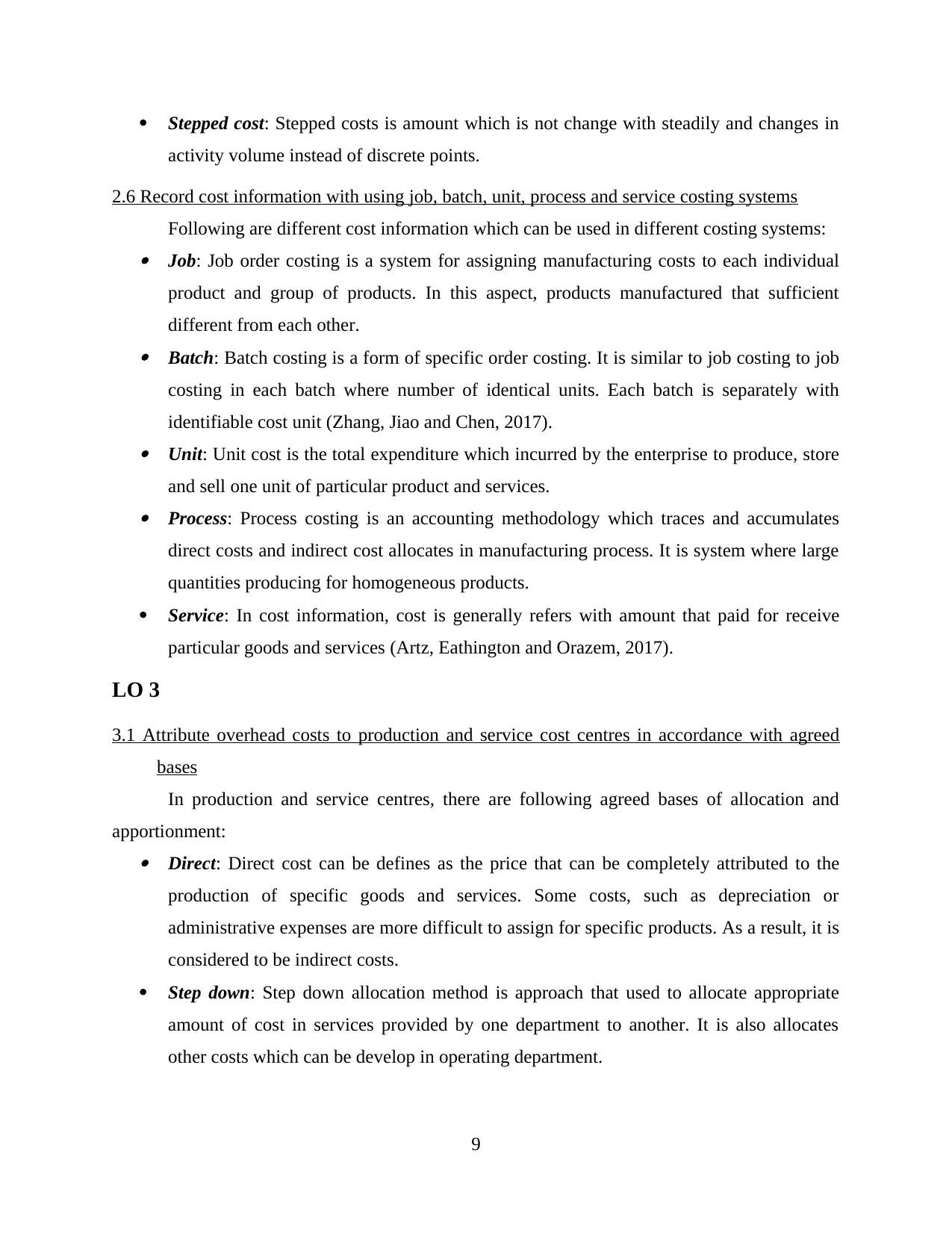
Stepped cost: Stepped costs is amount which is not change with steadily and changes in
activity volume instead of discrete points.
2.6 Record cost information with using job, batch, unit, process and service costing systems
Following are different cost information which can be used in different costing systems: Job: Job order costing is a system for assigning manufacturing costs to each individual
product and group of products. In this aspect, products manufactured that sufficient
different from each other. Batch: Batch costing is a form of specific order costing. It is similar to job costing to job
costing in each batch where number of identical units. Each batch is separately with
identifiable cost unit (Zhang, Jiao and Chen, 2017). Unit: Unit cost is the total expenditure which incurred by the enterprise to produce, store
and sell one unit of particular product and services. Process: Process costing is an accounting methodology which traces and accumulates
direct costs and indirect cost allocates in manufacturing process. It is system where large
quantities producing for homogeneous products.
Service: In cost information, cost is generally refers with amount that paid for receive
particular goods and services (Artz, Eathington and Orazem, 2017).
LO 3
3.1 Attribute overhead costs to production and service cost centres in accordance with agreed
bases
In production and service centres, there are following agreed bases of allocation and
apportionment: Direct: Direct cost can be defines as the price that can be completely attributed to the
production of specific goods and services. Some costs, such as depreciation or
administrative expenses are more difficult to assign for specific products. As a result, it is
considered to be indirect costs.
Step down: Step down allocation method is approach that used to allocate appropriate
amount of cost in services provided by one department to another. It is also allocates
other costs which can be develop in operating department.
9
activity volume instead of discrete points.
2.6 Record cost information with using job, batch, unit, process and service costing systems
Following are different cost information which can be used in different costing systems: Job: Job order costing is a system for assigning manufacturing costs to each individual
product and group of products. In this aspect, products manufactured that sufficient
different from each other. Batch: Batch costing is a form of specific order costing. It is similar to job costing to job
costing in each batch where number of identical units. Each batch is separately with
identifiable cost unit (Zhang, Jiao and Chen, 2017). Unit: Unit cost is the total expenditure which incurred by the enterprise to produce, store
and sell one unit of particular product and services. Process: Process costing is an accounting methodology which traces and accumulates
direct costs and indirect cost allocates in manufacturing process. It is system where large
quantities producing for homogeneous products.
Service: In cost information, cost is generally refers with amount that paid for receive
particular goods and services (Artz, Eathington and Orazem, 2017).
LO 3
3.1 Attribute overhead costs to production and service cost centres in accordance with agreed
bases
In production and service centres, there are following agreed bases of allocation and
apportionment: Direct: Direct cost can be defines as the price that can be completely attributed to the
production of specific goods and services. Some costs, such as depreciation or
administrative expenses are more difficult to assign for specific products. As a result, it is
considered to be indirect costs.
Step down: Step down allocation method is approach that used to allocate appropriate
amount of cost in services provided by one department to another. It is also allocates
other costs which can be develop in operating department.
9
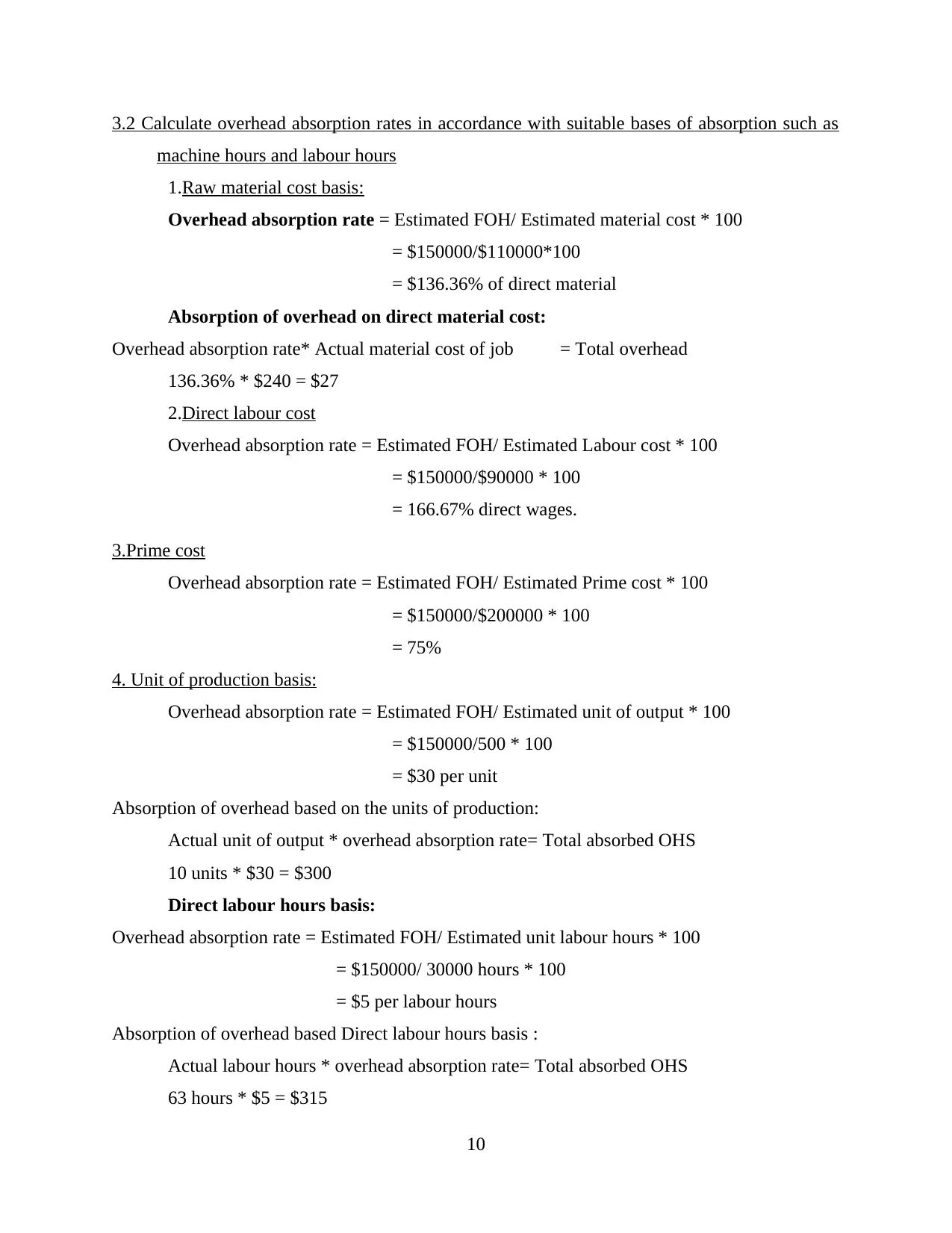
3.2 Calculate overhead absorption rates in accordance with suitable bases of absorption such as
machine hours and labour hours
1.Raw material cost basis:
Overhead absorption rate = Estimated FOH/ Estimated material cost * 100
= $150000/$110000*100
= $136.36% of direct material
Absorption of overhead on direct material cost:
Overhead absorption rate* Actual material cost of job = Total overhead
136.36% * $240 = $27
2.Direct labour cost
Overhead absorption rate = Estimated FOH/ Estimated Labour cost * 100
= $150000/$90000 * 100
= 166.67% direct wages.
3.Prime cost
Overhead absorption rate = Estimated FOH/ Estimated Prime cost * 100
= $150000/$200000 * 100
= 75%
4. Unit of production basis:
Overhead absorption rate = Estimated FOH/ Estimated unit of output * 100
= $150000/500 * 100
= $30 per unit
Absorption of overhead based on the units of production:
Actual unit of output * overhead absorption rate= Total absorbed OHS
10 units * $30 = $300
Direct labour hours basis:
Overhead absorption rate = Estimated FOH/ Estimated unit labour hours * 100
= $150000/ 30000 hours * 100
= $5 per labour hours
Absorption of overhead based Direct labour hours basis :
Actual labour hours * overhead absorption rate= Total absorbed OHS
63 hours * $5 = $315
10
machine hours and labour hours
1.Raw material cost basis:
Overhead absorption rate = Estimated FOH/ Estimated material cost * 100
= $150000/$110000*100
= $136.36% of direct material
Absorption of overhead on direct material cost:
Overhead absorption rate* Actual material cost of job = Total overhead
136.36% * $240 = $27
2.Direct labour cost
Overhead absorption rate = Estimated FOH/ Estimated Labour cost * 100
= $150000/$90000 * 100
= 166.67% direct wages.
3.Prime cost
Overhead absorption rate = Estimated FOH/ Estimated Prime cost * 100
= $150000/$200000 * 100
= 75%
4. Unit of production basis:
Overhead absorption rate = Estimated FOH/ Estimated unit of output * 100
= $150000/500 * 100
= $30 per unit
Absorption of overhead based on the units of production:
Actual unit of output * overhead absorption rate= Total absorbed OHS
10 units * $30 = $300
Direct labour hours basis:
Overhead absorption rate = Estimated FOH/ Estimated unit labour hours * 100
= $150000/ 30000 hours * 100
= $5 per labour hours
Absorption of overhead based Direct labour hours basis :
Actual labour hours * overhead absorption rate= Total absorbed OHS
63 hours * $5 = $315
10
⊘ This is a preview!⊘
Do you want full access?
Subscribe today to unlock all pages.

Trusted by 1+ million students worldwide
1 out of 19
Related Documents
Your All-in-One AI-Powered Toolkit for Academic Success.
+13062052269
info@desklib.com
Available 24*7 on WhatsApp / Email
![[object Object]](/_next/static/media/star-bottom.7253800d.svg)
Unlock your academic potential
Copyright © 2020–2025 A2Z Services. All Rights Reserved. Developed and managed by ZUCOL.





